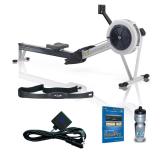Air Resistance Explained
Resistance on the Indoor Rower is adjusted by means of a damper lever on the side of the flywheel. Offering a wide range of resistance the damper lever increases or decreases the amount of air flow into the flywheel. The greater the airflow (damper setting 10), the greater the resistance and vice versa. Unfortunately some people confuse the damper settings with the value of the workout or their own fitness level. Here we try to dispel some of these misconceptions.
Myth: Rowing with more resistance will give a better workout.
Fact: The resistance setting is not a measure of your workout quality
or quantity.
The settings 1-10 on the Indoor Rower are not work level
settings or fitness level settings. The intensity of your workout is controlled
by how hard you pull on the handle and is calculated and displayed by the
electronic monitor as you row. Your accomplishment is indicated by the
monitor, not the setting of the wind damper. As your fitness level and
rowing skill improves you will be able to achieve better scores... i.e.
faster pace, higher watt output, or greater rate of calorie consumption...
regardless of the damper setting in which you choose to row. Think of the
Indoor Rower as your boat. If you row at low intensity you can row for
a long time. To make the boat go faster you pull harder; and if you try
to make the boat go very fast you will be exhausted in a short time. Air
resistance on the flywheel fan works just like the water resistance on
a boat.
Now that you are thinking in terms of a boat on the water, let's examine the effect of the damper settings 1-10. In the lower numbers 1-4 the feel of the Indoor Rower is like a sleek racing shell. In the higher numbers 6-10 the feel is like a big, slow rowing boat. Either boat can be rowed hard; and as you try to make either boat go fast, you will need to apply more force. Making the sleek boat go fast requires you to apply your force more quickly; and when trying to make the big boat go fast you will feel a high force but at a slower speed of application.
Question: "If I am exercising why don't I want to work at the
highest force possible?"
If you were weightlifting you would be interested in creating a high
force to work against. However, indoor rowing is intended to be a cardiovascular
workout lasting 20, 30 or more minutes. You should not be limited by muscular
fatigue before your cardiovascular system is able to benefit. Rowing in
a setting that results in too high a force can be detrimental to your training
programme by reducing your output, your enjoyment and the duration of your
workouts. You should choose the setting in which you can achieve your best
output score.
Question: "Wouldn't I get my best score in the lowest setting
... the sleekest boat?"
This would be true if the flywheel speed
were taken directly as the speed of your "boat". However the
electronic monitor is doing a lot of work while you exercise. As you are
moving forward for your next stroke the monitor measures how much your
flywheel is slowing down. It can determine precisely how sleek or slow
your "boat" is by how much it slows down between strokes. It
then uses this information to determine from the speed of the flywheel
how much work you are doing. In this way your true effort is calculated
regardless of damper setting.


